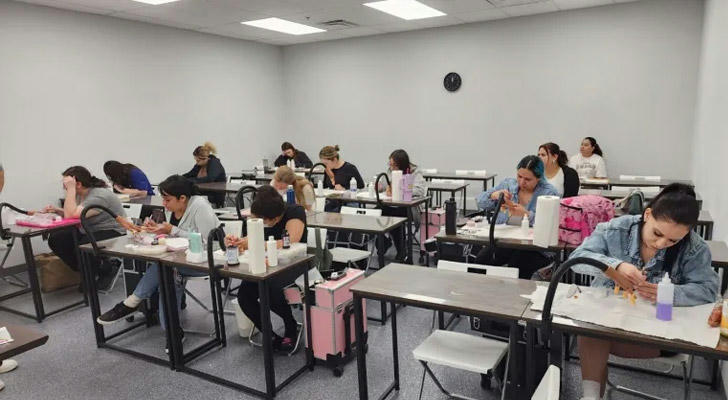A Closer Look at Hairdressing and Nail Art Courses: Real Feedback from Practitioners and a Full Industry Overview

The hairdressing and nail art industry has long been a stable career option due to its close ties to everyday consumer needs. However, with the flood of promotional materials and advertisements, many people still wonder: Are these beauty training courses truly reliable? Can learners actually gain practical skills? And what does the career path look like afterward?
To provide a clearer perspective, this article combines practitioner feedback, industry trends, and real-life cases to offer a comprehensive, objective analysis of these courses.
1. Course Content: A Balance Between Theory and Practice
Hair and nail courses on the market vary widely, offered by both large training institutions and independent tutors. Typically, these courses are divided into two core components:
Theoretical knowledge: covering basic anatomy of skin and hair, color theory, aesthetics, and sanitation practices.
Hands-on training: including shampooing, cutting, styling, coloring, nail techniques, hand and foot care, and product usage.
Experienced professionals agree that hands-on practice should account for at least 60% of the training. This is because beauty work relies heavily on practical skills and muscle memory. Feedback shows that students graduating from theory-heavy programs often lack the confidence or ability to perform in real scenarios.
Case 1:
An assistant now working in a hair salon mentioned that the initial short-term course focused too much on theory. After finishing the course, practical skills were still lacking. Real learning only began under the guidance of experienced stylists in a workplace setting.
Takeaway: A course’s credibility depends heavily on whether it emphasizes practical experience and offers real-world practice.
2. Quality of Training Providers Varies Greatly
Industry feedback shows that the quality of hair and nail courses can be inconsistent. Common issues include:
Outdated course content that doesn’t reflect current trends.
Inexperienced or frequently changing instructors.
Poor learning environments with outdated tools and limited resources.
Overcrowded classes with minimal hands-on opportunities.
Evaluating a course’s reliability means looking beyond the brochure. Key factors to assess include the provider’s teaching methodology, instructor qualifications, and training environment. Visiting the institution, attending a trial class, or reviewing feedback from former students is highly recommended.
Case 2:
A newly certified nail technician shared that their first course lacked structured instruction and real-world training. Most practice was done independently. Only after enrolling in a more comprehensive course did they start to understand customer needs and how to match styles accordingly.
Tip: Always request a trial class and check if the institution is certified or follows industry-standard teaching procedures.

3. Career Paths Are Diverse and Not Limited to Frontline Roles
There’s a common misconception that graduates of hair and nail courses are limited to entry-level roles. In reality, career paths in the beauty industry are quite diverse:
Hairdressing: Assistant → Junior Stylist → Hair Designer → Manager or Partner
Nail Art: Trainee → Independent Nail Technician → Business Owner or Freelancer
Advanced paths: Trainer, Product Educator, Image Consultant
With experience and continued learning, many professionals eventually become freelancers, entrepreneurs, or educators in the field.
Case 3:
One nail technician started a personal studio after a year of training and gained experience working for a chain salon. After building a client base via social media, they rented a small workspace and now manage a steady flow of customers while mentoring a trainee.
Insight: Career growth in beauty services depends on ongoing learning and building a personal brand or client base.
4. Industry Trends: Skills and Service Redefine Value
The hair and nail industry remains steady in demand across many areas. With growing preferences for personalization and aesthetics, customers now value both technical ability and the overall service experience.
Modern consumers expect practitioners to be not only technically skilled but also style-savvy and communicative. As a result, training now emphasizes both hard skills and soft skills.
Key industry trends include:
Greater focus on customer experience and communication.
Creative and trend-aligned styles gaining popularity.
Personal branding through social platforms.
Increased awareness of hygiene, product knowledge, and safety.
Conclusion: Beauty work is evolving into a blend of artistry, service, and customer engagement. Training programs must reflect this shift to remain relevant.

5. Practitioner Feedback: Growth Comes with Effort
Practitioners widely acknowledge that while beauty training is accessible, mastering the craft and standing out requires persistence and dedication.
Common challenges include:
Long hours and repetitive practice during the early stage.
Needing strong interpersonal skills to meet client expectations.
High industry competition demanding continuous skill upgrades.
Rapid style changes requiring ongoing education.
Positive feedback often highlights:
The satisfaction of mastering a skill and delivering quality work.
Emotional rewards from meeting client needs.
Flexibility to work in various settings and platforms.
6. Final Thoughts: Training Is Just the Beginning
Ultimately, whether a hair or nail course is “worth it” depends on multiple factors—course structure, institution credibility, and, most importantly, the learner’s dedication and long-term goals.
These courses provide a solid foundation, not a guaranteed outcome. Choosing the right course, understanding the industry, and committing to improvement are key to sustainable success.
For those considering entering the beauty field, it’s essential to make informed decisions by reviewing course structures, understanding practical requirements, and recognizing that skills and professionalism grow over time.
If further assistance is needed to evaluate a specific course or compare training options, feel free to request a detailed checklist or course evaluation guide.
